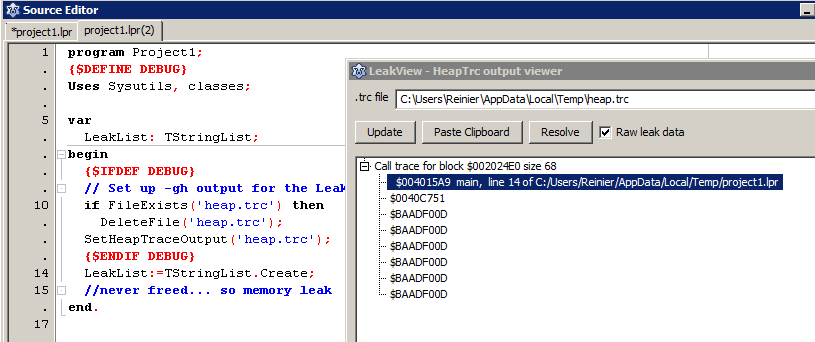Difference between revisions of "leakview"
m |
|||
| Line 10: | Line 10: | ||
To enable this in your Lazarus project: go to Project Options/Linking and in the Debugging section enable ''Use Heaptrc unit (check for mem-leaks) (-gh)'' | To enable this in your Lazarus project: go to Project Options/Linking and in the Debugging section enable ''Use Heaptrc unit (check for mem-leaks) (-gh)'' | ||
| − | You can then let the program log the output of the heaptrc unit to a file. Add the following code fragments in your .lpr, at the beginning of your code: | + | You can then let the program log the output of the heaptrc unit to a file. Add the following code fragments in your .lpr, at the beginning of your code to redirect the heaptrc output to file: |
<syntaxhighlight> | <syntaxhighlight> | ||
{$DEFINE debug} // do this here or you can define a -dDEBUG in Project Options/Other/Custom Options, i.e. in a build mode so you can set up a Debug with leakview and a Default build mode without it | {$DEFINE debug} // do this here or you can define a -dDEBUG in Project Options/Other/Custom Options, i.e. in a build mode so you can set up a Debug with leakview and a Default build mode without it | ||
| Line 36: | Line 36: | ||
end. | end. | ||
</syntaxhighlight> | </syntaxhighlight> | ||
| − | + | ||
=== Enabling heaptrc in FPC === | === Enabling heaptrc in FPC === | ||
Revision as of 10:23, 22 April 2014
Overview
Leakview allows fast navigation trough HeapTrc (and other?) leaks.
Usage
Leakview reads heaptrc output. For this to work, you'll need to enable heaptrc in your code:
Enabling heaptrc in Lazarus
To enable this in your Lazarus project: go to Project Options/Linking and in the Debugging section enable Use Heaptrc unit (check for mem-leaks) (-gh)
You can then let the program log the output of the heaptrc unit to a file. Add the following code fragments in your .lpr, at the beginning of your code to redirect the heaptrc output to file:
{$DEFINE debug} // do this here or you can define a -dDEBUG in Project Options/Other/Custom Options, i.e. in a build mode so you can set up a Debug with leakview and a Default build mode without it
uses
...
{$IFDEF debug}
, SysUtils
{$ENDIF}
...
begin
{$IFDEF DEBUG}
// Assuming your build mode sets -dDEBUG in Project Options/Other when defining -gh
// This avoids interference when running a production/default build without -gh
// Set up -gh output for the Leakview package:
if FileExists('heap.trc') then
DeleteFile('heap.trc');
SetHeapTraceOutput('heap.trc');
{$ENDIF DEBUG}
...
end.
Enabling heaptrc in FPC
In FPC, you can specify -gh in your compiler options or include the heaptrc unit in your uses clause (as one of the first items).
Then redirect the heaptrc output to file (instead of standard output). You can use similar code to the Lazarus code or alternatively, set the environment variable, e.g. on *nix:
export HEAPTRC="log=heap.trc"
or Windows:
set HEAPTRC="log=heap.trc"
